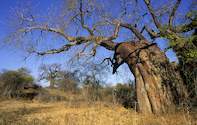
During game drives in the Kruger National Park (KNP), it is doubtful if the many people peering out at the trees and grass in the hopes of seeing a lion ever wonder "How come there are both trees and grass growing here? If one tree can grow so big here, why aren't there more? How come the grass doesn't suffocate all the tree seedlings?"
A seed has a hard time becoming a tree. It may take years before a seed can germinate and the seedling gets the right rainfall to survive the first growing season. The sapling has to compete with grasses, survive browsing by antelopes, and get through fires. Landscapes with trees and grass are typical of a savanna ecosystem, and what makes the system thrive has been the subject of much scientific endeavour.
The main factors that change how a savanna looks over time include soils, browsing and grazing by animals, and how often fires have blazed across the landscape. The relative importance of these factors is hard to pinpoint as they change from year to year. To try and isolate exactly what is going on, the University of Cape Town and KNP is running a suite of research projects called the Tree/Grass Programme.
The programme focuses on understanding how fire and rainfall eventually change the proportion of trees and grasses. With a deeper understanding of the system, the scientists will be able to more accurately judge how the savanna is coping with environmental changes. The limits of acceptable change ("thresholds of potential concern") that park management uses to watch over Kruger's flora and fauna can also be refined.
Since October 2002, programme manager Louise Rademan and her team in Kruger have been monitoring 48 four by four metre plots in the hopes of finding out exactly how rainfall and competition between trees and grass affects the savanna. They have no control over how much rain falls out of the sky, but can control how much of that rain hits the earth in the experimental plots.
Some of the plots have been partially roofed with clear sheets, stopping half of the rain from reaching the ground. The rain collected off the roof irrigates nearby plots, giving them more water. Other plots get normal rainfall. To look at competition between trees and grass, some plots have a tree and grass, some grass only, some have a tree with no grass, and some have no trees or grass.
Each tree plot was carefully chosen so that an established tree fell in the centre of the plot. The tree/grass combinations then get different rainfall. Altogether there are eight combinations of trees, grass and rainfall, each of which is repeated six times. The project is being run in Pretoriuskop where there is over 700mm of rainfall, and near Satara where it is drier (500mm).
Near Satara the trees studied are Acacia nigrescens (knobthorn) and at Pretoriuskop, Terminalia sericea (silver cluster leaf). To try and isolate rainfall influence, the experiment is carried out in a fenced enclosure to prevent animals from eating the study material and damaging monitoring equipment.
Fires will also not be allowed in the plots for the duration of the experiment. Readings of weather and soil moisture are continuously kept by computerised equipment at both sites. Every month, all 48 plots are visited and the amount of grass on each is measured, along with detailed measurements of how each tree is faring. Soil moisture measurements are also taken.
Although only two growing seasons of data have been collected so far, interesting results are being revealed. Louise says, "It seems that the competitive environment is making a bigger difference to plant growth than rainfall does." The experiments have shown that 'good' rain years in Kruger may not be good for young trees. Changing the rainfall did not affect tree growth significantly, but removing the grass did.
Grass growth increased and decreased according to the rainfall. The irrigation treatments suggest that grass growth is so vigorous in a wet year that the tree does not benefit. The rainout shelters and grass removal treatments suggest that the dry years, with no grass to steal the water, or to fuel the fires, seem to be the ones when the young trees get their chance. "This is a huge surprise that would not have been revealed without the experiments."
The experiment is planned to run for about eight more years, with further time depending on funding. The programme is also keen to discover how long it takes the trees to reach three or four metres, the height at which a tree is thought to be able to avoid death or stunting from a fire.
Time will tell if the trends that have been uncovered at this early stage will remain the same over the next decade, and what they imply for bigger areas and longer times. Each bit of knowledge gained will begin to fill in missing gaps in the puzzle of tree/grass interactions.
One day Kruger's managers might be able to create a computer model to manage a virtual savanna, watching trees and grass flourish or perish in cyber space, allowing the tourist in his car to continue looking out his window for lions, never giving a thought to all the trees and grass he passes.

 Fire is often thought of something that trees should be protected from, but a new study suggests that some trees may themselves contribute t...
Fire is often thought of something that trees should be protected from, but a new study suggests that some trees may themselves contribute t...